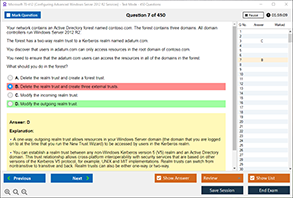Overview of the CompTIA SY0-601 Exam
The CompTIA Security+ (SY0-601) exam is a globally recognized certification that validates the foundational skills required to perform core security functions and pursue an IT security career. This exam is designed for IT professionals who have a basic understanding of security concepts and are looking to deepen their knowledge in areas such as threats, vulnerabilities, and risk management. One of the critical topics covered in the SY0-601 exam is buffer overflow, a common vulnerability that can lead to severe security breaches if not properly mitigated.
Buffer overflow is a topic that every aspiring security professional must understand thoroughly. It is not only a common question in the SY0-601 exam but also a real-world issue that can have devastating consequences. In this article, we will delve into the concept of buffer overflow, explore the characteristics of languages susceptible to this vulnerability, identify the most vulnerable programming languages, and discuss how to mitigate buffer overflow risks. By the end of this article, you will have a comprehensive understanding of buffer overflow and how to protect your systems from this critical vulnerability.
Definition of Buffer Overflow
Buffer overflow is a software vulnerability that occurs when a program writes more data to a buffer (a temporary storage area) than it can hold. This excess data can overwrite adjacent memory locations, leading to unpredictable behavior, crashes, or even the execution of malicious code. Buffer overflow is one of the most common and dangerous vulnerabilities in software, often exploited by attackers to gain unauthorized access to systems, escalate privileges, or execute arbitrary code.
The root cause of buffer overflow is often poor programming practices, such as failing to validate input data or using unsafe functions that do not perform bounds checking. When a program does not check the size of the data being written to a buffer, it becomes susceptible to buffer overflow attacks. These attacks can be particularly devastating because they allow attackers to manipulate the program's execution flow, potentially leading to a complete compromise of the system.
Characteristics of Languages Susceptible to Buffer Overflow
Not all programming languages are equally susceptible to buffer overflow vulnerabilities. Some languages have built-in features that make them more prone to these types of attacks, while others are designed with security in mind and include mechanisms to prevent buffer overflow. The following are some characteristics of languages that are more susceptible to buffer overflow:
1. Manual Memory Management: Languages that require manual memory management, such as C and C++, are more prone to buffer overflow vulnerabilities. In these languages, the programmer is responsible for allocating and deallocating memory, which can lead to errors if not done correctly. For example, if a programmer allocates a buffer of a certain size but fails to check the size of the data being written to it, a buffer overflow can occur.
2. Lack of Bounds Checking: Some languages do not perform bounds checking, which means they do not verify whether the data being written to a buffer exceeds its allocated size. This lack of bounds checking is a significant factor in buffer overflow vulnerabilities. Languages like C and C++ do not have built-in bounds checking, making them more susceptible to these types of attacks.
3. Unsafe Functions: Certain programming languages provide functions that are inherently unsafe and can lead to buffer overflow if not used correctly. For example, the `strcpy()` function in C copies a string from one buffer to another without checking the size of the destination buffer. If the source string is larger than the destination buffer, a buffer overflow will occur.
4. Low-Level Access: Languages that provide low-level access to memory and hardware are more susceptible to buffer overflow vulnerabilities. These languages allow programmers to manipulate memory directly, which can lead to errors if not done carefully. C and C++ are examples of languages that provide low-level access, making them more prone to buffer overflow.
Most Vulnerable Programming Languages
While buffer overflow vulnerabilities can occur in any programming language, some languages are more susceptible than others due to their design and features. The following are some of the most vulnerable programming languages:
1. C: C is one of the most widely used programming languages, but it is also one of the most vulnerable to buffer overflow attacks. C provides low-level access to memory and does not perform bounds checking, making it easy for programmers to make mistakes that lead to buffer overflow. Additionally, C includes many unsafe functions, such as `strcpy()` and `gets()`, which can easily lead to buffer overflow if not used correctly.
2. C++: C++ is an extension of C and shares many of its vulnerabilities, including susceptibility to buffer overflow. Like C, C++ requires manual memory management and does not perform bounds checking, making it prone to buffer overflow vulnerabilities. While C++ includes some features that can help mitigate buffer overflow, such as the Standard Template Library (STL) and smart pointers, these features are not always used correctly, leaving programs vulnerable to attack.
3. Assembly Language: Assembly language is a low-level programming language that provides direct access to hardware and memory. Because assembly language is so close to the hardware, it is highly susceptible to buffer overflow vulnerabilities. Programmers writing in assembly language must be extremely careful to manage memory correctly and avoid buffer overflow, but even experienced programmers can make mistakes.
4. Fortran: Fortran is an older programming language that is still used in some scientific and engineering applications. Fortran does not perform bounds checking and includes many unsafe functions, making it susceptible to buffer overflow vulnerabilities. While Fortran is not as widely used as C or C++, it is still important to be aware of its vulnerabilities, especially in legacy systems.
Languages That Mitigate Buffer Overflow Risks
While some programming languages are more susceptible to buffer overflow vulnerabilities, others are designed with security in mind and include features that help mitigate these risks. The following are some programming languages that are less susceptible to buffer overflow:
1. Java: Java is a high-level programming language that includes built-in bounds checking and automatic memory management. Java's runtime environment (JVM) performs bounds checking on array accesses and throws an exception if an out-of-bounds access is attempted. Additionally, Java's garbage collector automatically manages memory, reducing the risk of buffer overflow vulnerabilities.
2. Python: Python is a high-level programming language that is designed to be easy to read and write. Python includes built-in bounds checking and automatic memory management, making it less susceptible to buffer overflow vulnerabilities. Additionally, Python's high-level abstractions and extensive standard library make it easier for programmers to write secure code.
3. C#: C# is a modern programming language developed by Microsoft that includes many features designed to improve security. C# includes bounds checking and automatic memory management, reducing the risk of buffer overflow vulnerabilities. Additionally, C# includes features such as nullable types and exception handling that help programmers write more secure code.
4. Rust: Rust is a systems programming language that is designed to be safe and concurrent. Rust includes built-in bounds checking and a unique ownership model that prevents common programming errors, including buffer overflow. Rust's compiler enforces strict rules on memory management, making it difficult for programmers to introduce buffer overflow vulnerabilities.
How to Mitigate Buffer Overflow Vulnerabilities?
While some programming languages are more susceptible to buffer overflow vulnerabilities, there are several best practices that programmers can follow to mitigate these risks, regardless of the language they are using. The following are some strategies for mitigating buffer overflow vulnerabilities:
1. Use Safe Functions: One of the most effective ways to prevent buffer overflow is to use safe functions that perform bounds checking. For example, in C, programmers should use functions like `strncpy()` instead of `strcpy()`, as `strncpy()` allows the programmer to specify the maximum number of characters to copy. Similarly, in C++, programmers should use the STL and smart pointers to manage memory safely.
2. Validate Input Data: Another important strategy for preventing buffer overflow is to validate input data. Programmers should always check the size of input data before writing it to a buffer and ensure that it does not exceed the buffer's allocated size. Input validation should be performed at both the client and server sides to ensure that all data is safe.
3. Use Modern Programming Languages: As discussed earlier, some programming languages are less susceptible to buffer overflow vulnerabilities due to their design and features. Programmers should consider using modern programming languages like Java, Python, C#, or Rust, which include built-in bounds checking and automatic memory management.
4. Enable Compiler Protections: Many modern compilers include features that can help mitigate buffer overflow vulnerabilities. For example, the GCC compiler includes the `-fstack-protector` option, which adds a canary value to the stack to detect buffer overflow. Programmers should enable these compiler protections to reduce the risk of buffer overflow.
5. Perform Regular Code Reviews: Regular code reviews are an essential part of any secure development process. Code reviews allow programmers to identify and fix potential buffer overflow vulnerabilities before they can be exploited. Code reviews should be performed by experienced programmers who are familiar with secure coding practices.
6. Use Static Analysis Tools: Static analysis tools can help identify potential buffer overflow vulnerabilities in code before it is deployed. These tools analyze the code for common programming errors, including buffer overflow, and provide recommendations for fixing them. Programmers should use static analysis tools as part of their development process to ensure that their code is secure.
7. Implement Address Space Layout Randomization (ASLR): ASLR is a security technique that randomizes the memory addresses used by a program, making it more difficult for attackers to exploit buffer overflow vulnerabilities. ASLR is supported by most modern operating systems and should be enabled to reduce the risk of buffer overflow attacks.
8. Use Non-Executable Stacks: Another effective strategy for mitigating buffer overflow vulnerabilities is to use non-executable stacks. A non-executable stack prevents attackers from executing code that has been injected into the stack via a buffer overflow. Most modern operating systems support non-executable stacks, and this feature should be enabled to enhance security.
Conclusion
Buffer overflow is a critical vulnerability that can lead to severe security breaches if not properly mitigated. Understanding buffer overflow and how to protect against it is essential for any IT security professional, especially those preparing for the CompTIA SY0-601 exam. By following best practices such as using safe functions, validating input data, and using modern programming languages, programmers can reduce the risk of buffer overflow vulnerabilities in their code.
Additionally, enabling compiler protections, performing regular code reviews, and using static analysis tools can help identify and fix potential buffer overflow vulnerabilities before they can be exploited. Implementing security techniques such as ASLR and non-executable stacks can further enhance the security of a system and reduce the risk of buffer overflow attacks.
In conclusion, buffer overflow is a complex and dangerous vulnerability, but with the right knowledge and tools, it can be effectively mitigated. By understanding the characteristics of languages susceptible to buffer overflow, identifying the most vulnerable programming languages, and following best practices for secure coding, programmers can protect their systems from this critical vulnerability and ensure the security of their applications.
Special Discount: Offer Valid For Limited Time “SY0-601 Exam” Order Now!
Sample Questions for CompTIA SY0-601 Dumps
Actual exam question from CompTIA SY0-601 Exam.
Which of the following programming languages is most susceptible to buffer overflow attacks?
A. Python
B. Java
C. C
D. Swift


